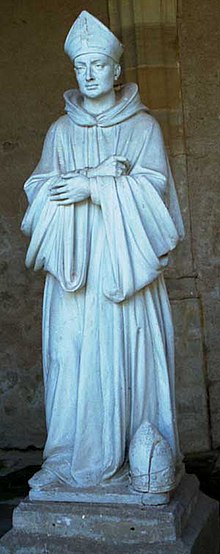Maiolus
Maiolus (* 910 in Valensole in Provence ; † May 11, 994 in Souvigny ) was a nobleman , priest and Benedictine . For forty years, from 954 to 994, he determined Cluny's fate - initially, until 964, as a representative of the blind abbot Aymardus . When he resigned in 964 (he died a year later), Maiolus became the fourth abbot of Cluny and contributed significantly to the expansion of the reform movement that started from Cluny . He was one of the most important abbots of Cluny and immediately after his death - as the first abbot of Cluny - was venerated as a saint , whereby his cult was very widespread in the Middle Ages. His feast day is May 11th. Other spellings of his name are: Majolus, Mayeul or Maieul.
origin
Maiolus comes from one of the oldest Provencal noble families in southern France , the Lords of Apt , who later called themselves d'Agoult. The first known representative of the family is Foucher, the grandfather of Maiolus, who lived in the 9th century. The father of Maiolus was Foucher II, Lord of Apt (+ around 915), who married Mayeul's mother, Raimonde de Narbonne, a daughter of Mayeul Vicomte de Narbonne , on September 3, 909 . A slightly different representation of the origin of Maiolus can be found in the documentation by Charles Cawley in "Medieval Lands": According to this, the mother of Maiolus, Raymonde de Narbonne, a daughter of Gautier, the second Viscount (vice count) of Narbonne (+ after June 15, 911), and thus not daughter, but granddaughter of Mayeul I, Vicomte de Narbonne (+ before June 15, 911), and a sister of Mayeul III, Viscount de Narbonne, who died after October 24, 946 , been.
Abbot of Cluny
Maiolus studied in Lyon and Macon, was initially a secular priest, entered the Cluny monastery as a monk in 943 or 944 and became coadjutor in 948, deputy in 954 and successor in 964 to abbot Aymardus (Aymard), who was blind.
Thanks to its popularity and the cult of remembrance of the dead, which was promoted by the monastery, the monastery, under the direction of Maiolus, acquired large fortunes through donations and inheritances, so that it had around 900 villages, numerous parishes, pensions and taxes. From 967 Maiolus continued the reform begun by Abbot Odo von Cluny (927-942) and introduced the Benedictine rule in many monasteries , with his influence extending far beyond France and also having an impact in Germany and Italy. At the same time, he managed to get Cluny to exercise close control over the affiliated monasteries. As abbot he was the head of the Cluniac reform movement and is one of the most important abbots of Cluny, who led the abbey to spiritual and economic prosperity. Under Maiolus, the construction of the new monastery church Cluny II began in 955, which was inaugurated on February 14, 981 by the Archbishop of Lyon. This building was one of the greatest church structures of the time.
In July 972 Maiolus was kidnapped by Saracens near Orsières , who at that time had a bridgehead in Fraxinetum (in Burgundy, near Fréjus ). Maiolus was only released after paying a large ransom, for which many cult objects and parts of the Cluny treasure had to be melted down. The retaliatory action taken by Count William I of Provence afterwards led to the Battle of Tourtour in 973 and the expulsion of the Saracens from Provence.
Maiolus appointed Odilon de Mercœur as his successor and died on May 11, 994 in the monastery of Saint-Pierre-et-Saint-Paul de Souvigny in the Bourbonnais (today the Allier department ) on the journey to Saint-Denis , where King Hugo Capet had invited him to reform the monastery there.
Saint
Maiolus was the first abbot of Cluny to be venerated as a saint immediately after his death. Both his role as a reformer and liberator of the monasteries from the influence of lay people and bishops as well as his (indirect) role in the liberation of Provence from the Saracens contributed to this.
Thanks to his personality, his cult was very widespread in the Middle Ages. For example, the King of France Hugo Capet went on a pilgrimage to the saint's grave in Souvigny as early as 996. In 998 the first German Pope Gregor V (996 - 999) - Bruno of Carinthia from Stainach in the Styrian Ennstal (today in Styria / Austria) - confirmed the holiness of Abbot Maiolus von Cluny in a bull. Also , Robert II "the Pious" King of France (996 - 1031) made a pilgrimage to the grave of the Holy 1019/20.
Individual evidence
- ↑ Wiki article in French "Mayeul de Cluny"
- ↑ Wiki article in French "Mayeul de Cluny"
- ↑ Wiki article in French "Famille d´Agoult"
- ↑ Detlev Schwennike, European Family Tables Volume XIV, Marburg Verlag von JA Stargardt 1991, Table 9
- ↑ Charles Cawley in "Medieval Lands" [1]
- ↑ Wiki article in French: Mayeul de Cluny
- ↑ Wiki article in French: Mayeul de Cluny
literature
- Johannes Madey : Maiolus. In: Biographisch-Bibliographisches Kirchenlexikon (BBKL). Volume 16, Bautz, Herzberg 1999, ISBN 3-88309-079-4 , Sp. 978-979.
| predecessor | Office | successor |
|---|---|---|
| Aymardus |
Abbot of Cluny 954-994 |
Odilo |
| personal data | |
|---|---|
| SURNAME | Maiolus |
| ALTERNATIVE NAMES | Majolus; Mayeul; Maieul |
| BRIEF DESCRIPTION | Nobleman, priest, Benedictine, abbot of Cluny |
| DATE OF BIRTH | 910 |
| PLACE OF BIRTH | Valensole in Provence |
| DATE OF DEATH | May 11, 994 |
| Place of death | Souvigny |
